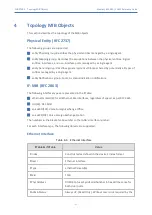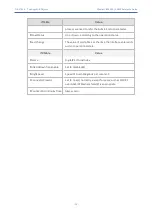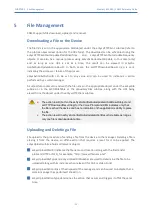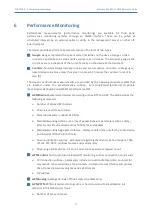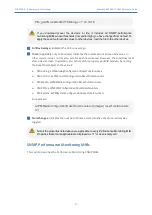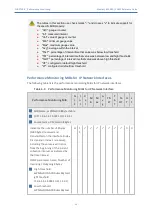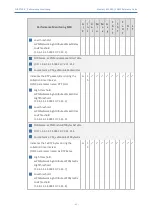
CHAPTER 6 Performance Monitoring
Mediant 800 SBC | SNMP Reference Guide
●
Trunk activity
●
Number of channels that are in/out of service and in maintenance
■
acPMSystem:
General device monitoring:
●
IP connection.
●
Discarded UDP packets due to unknown port
●
System Net Utils subtree – transmitted/received bytes/packets, discarded packets
●
System Network subtree – DHCP response time/request count and STUN-related
statistics
●
System Multicast subtree – multicast IP packets received, multicast IP packets
conveying UDP payload packets received/rejected, IGMP packets/general-
queries/specific-queries received, IGMP membership-report/leave-group sent
messages
●
System Congestion subtree – congestion state for general resources, DSP resources,
IP resources, conference resources
●
System NFS subtree – NFS-related parameters
Performance monitoring MIBs all have an identical, fixed structure, which includes two major
subtrees:
■
Configuration subtree:
Allows configuration of general attributes of the MIB and specific
attributes of the monitored objects. This subtree includes:
●
Reset Total Counters: Resets the "total" (see below) objects in all the MIB’s tables, if
they are defined.
●
Attributes subtrees: Number of subtrees in which scalars are used to configure high
and low thresholds for relevant tables.
■
Data subtree:
Consists of monitored data and statistics, and includes:
●
Time From Start Of Interval object: GETs the time in seconds from the beginning of the
current interval.
●
Data tables: All have similar structure. Not all possible columns appear in all of them.
The specific structure of a table (i.e. what columns are defined) is parameter specific.
The only column that always appears is the interval column. The information in each
column is a statistical attribute of the parameter being measured.
The device measures performance at fixed intervals of 15 minutes. The device keeps a record
of the last two completed intervals. These intervals are used as a key in the MIB tables in which
the performance monitoring results are presented. There are one or two indices in each table.
If there are two, the first is a sub-set in the table (e.g., trunk number) and the second (or the
single where there is only one) index represents the interval number:
■
0:
Current interval (not completed)
■
1:
Last completed interval
- 28 -








